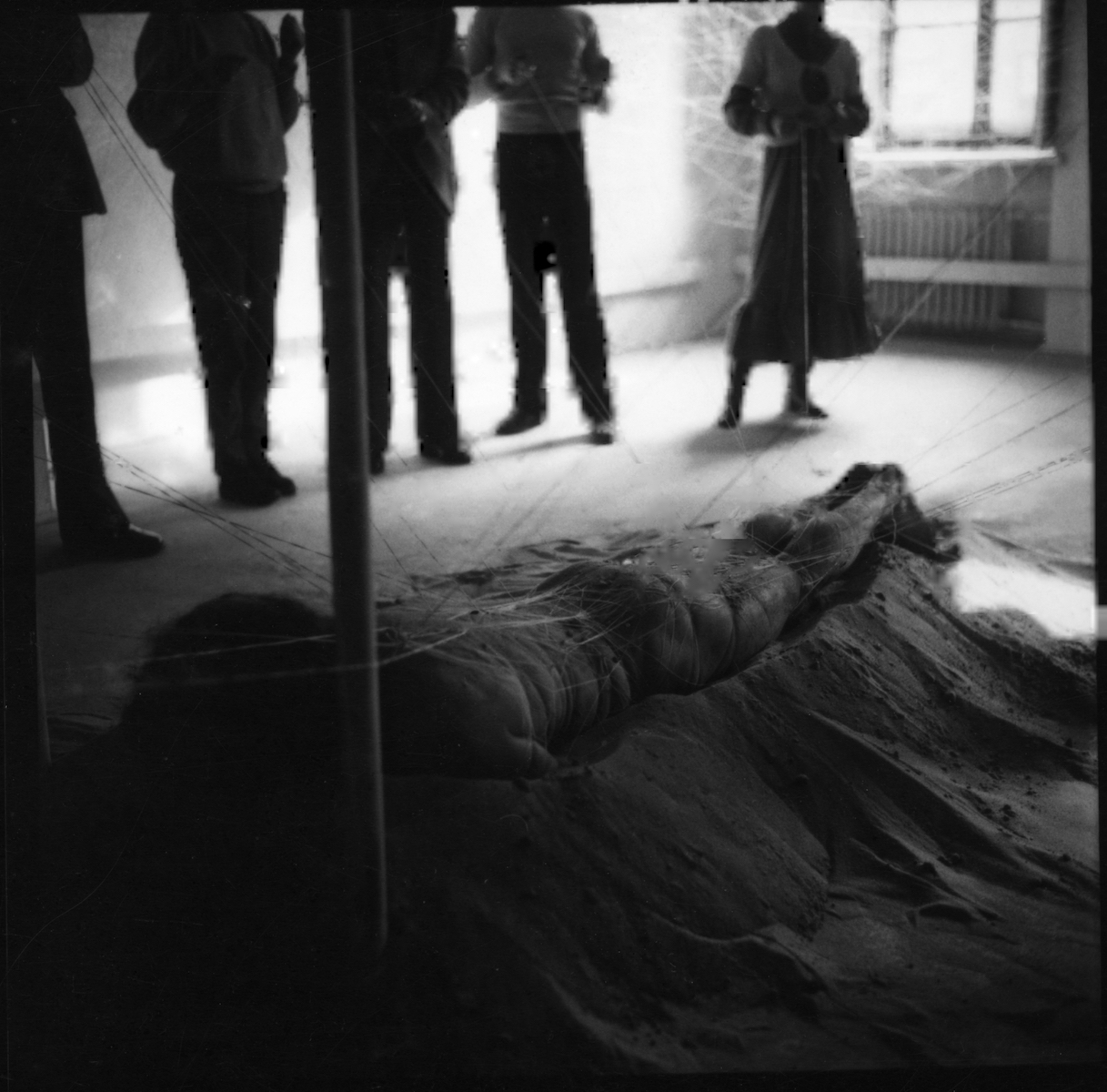20-30 05 1980
performance 20/05, wykonawca: Krzysztof Jung
„still life” (wystawa scenerii pozostałej po działaniu) 21-30/05
Galeria Re'Repassage, Warszawa
Creating through the others and the horizon of freedom
20-30 05 1980
performance 20/05, performer: Krzysztof Jung
“still life" exhibition 21-30/05
Re'Repassage Gallery, Warsaw
Czym
jest stwarzanie poprzez innych jak nie ciągłym obcowaniem z innymi? A przecież
być wśród ludzi, być dla ludzi to nieomal nasza instynktowna, biologiczna
potrzeba. Walczyć więc o pełną wolność dla własnej indywidualności — nie, nie,
to zbyt zarozumiałe twierdzić, że tę indywidualność naprawdę posiadam. To
mnogość żywotów ludzkich jest tym, co posuwa nas w czasie i w nas się wyraża.
Siebie — poddanych oddajemy „machinie wzajemnych stwarzań”, której czas jest
największym sprzymierzeńcem. Ale jest też czas inny, który chroni to, co jest
we mnie moje, to czego werbalnie sformułować nie umiem. Język - system umownych
znaków — jest bezradny wobec treści żyjących tym czasem. To czas płynący
pionowo, choć zależny od czasu samorodnego, ma własną, nieskończoną skalę —
horyzont wolności. Obojętnie, czy jestem przedmiotem czy podmiotem w tym czasie
samorodnym, zawsze zapatrzony jestem w swój horyzont wolności — wizję
nieosiągalną.
Krzysztof Jung
tekst towarzyszący
wystawie, maszynopis, Arch. Repassage
Is creating through the others anything else but a ceaseless being in
commune with the others? Surely, being among people, being for people is
practically our instinctive biological need. So, a struggle for unlimited
freedom to express one's individuality — no, no, it is presumptuous to say that
I am truly individual. It is the multitude of human lives which makes us go
forward in time and is expressed through us. We give ourselves, the subjects,
to the 'machine of mutual creating' which has the time as its greatest ally.
But there is also another kind of time which protects what is mine in me, what
I cannot express in words. Language, a system of signs agreed upon, cannot
handle the meanings which dwell in this time. This kind of time flows
vertically. Although it is dependent on time arising spontaneously, it has its
own unlimited scale — the horizon of freedom. Regardless of whether I am the
subject or the object in the time arising spontaneously, I constantly fix my
eyes on my horizon of freedom — a vision unattainable.
Krzysztof Jung
text accompanying the exhibition, typescript, Arch. Repassage,
translated by Maria Olejniczak
Pokaz
odbywał się wiosną, przy odsłoniętych oknach galerii. Wśród publiczności, poza
ludźmi galerii byli Anna i Krystyn Jarnuszkiewiczowie, Janusz Bogucki,
Przemysław Kwiek, a także studenci rzeźby, Marek Sarełło i Rafał Szambelan.
Stanęliśmy w kręgu. Mary Olejniczak wręczyła każdemu koniec nitki wysnutej z
leżącej centralnie kupy piachu. Z czasem piach zaczął się ruszać, po czym,
naciągając nasze nici, wyłonił się z niego Krzyś.
Czyścił
się z piasku (ciągle „uwiązany” do nas), a następnie zaczął tkać konstrukcję,
coś w rodzaju nicianej drabiny między czterema białymi rurami. W trakcie tej
pracy nici łączące go z nami w naturalny sposób zostały zerwane.
Gdy
konstrukcja była dość gęsta, zaczął się po niej wspinać, ciągle tkając ją ku
górze. Na koniec zawisł ok. 1,5 m nad podłogą w siatce z nici.
Dalszym
ciągiem tej pracy było posadzenie
fasolek w piachu, z którego „powstał” Krzyś (nie pamiętam, czy mimo podlewania
coś tam urosło) oraz podwiązaniu do resztek nici kamienia. Te bardzo efektowne
resztki po działaniu Krzysia były wystawione w galerii jako „still life”.
Grzegorz
Kowalski, 1999
The performance took place in the spring; the windows of the gallery were
uncovered. Apart from the “Repassage people", there were Anna and Krystyn Jarnuszkiewicz, Janusz Bogucki,
Przemysław Kwiek, and the students of the Department of Sculpture — Marek
Sarełło and Rafał Szambelan — among the spectators. We all stood in a circle.
Mary Olejniczak gave each of us one end of a thread which was drawn out from a
pile of sand lying in the centre. After some time the pile started to move, and
then our threads stretched and Krzyś got up from the sand.
He brushed the sand off his body (still ‘tied’ to us), and then he
started to weave the threads into a construction, which resembled a kind of
ladder, among four white poles standing on the floor and reaching up to the
ceiling. While he was doing it the threads which connected him with us broke as
a matter of course.
When the construction was dense enough, Krzyś started to climb it, still
weaving it further up. Finally he stayed suspended in a net of threads some 1.5
metres above the floor.
This work had its continuation — some beans were planted on the sand
from which Krzyś ‘rose’ (I do not remember whether they shot up in spite of
being watered) and the trailing treads were tied to a piece of stone, an
ordinary cobble-stone. These spectacular remains of his action were exhibited
in the gallery in the form of ‘still life’.
Grzegorz Kowalski, 1999
translated by Maria Olejniczak

















